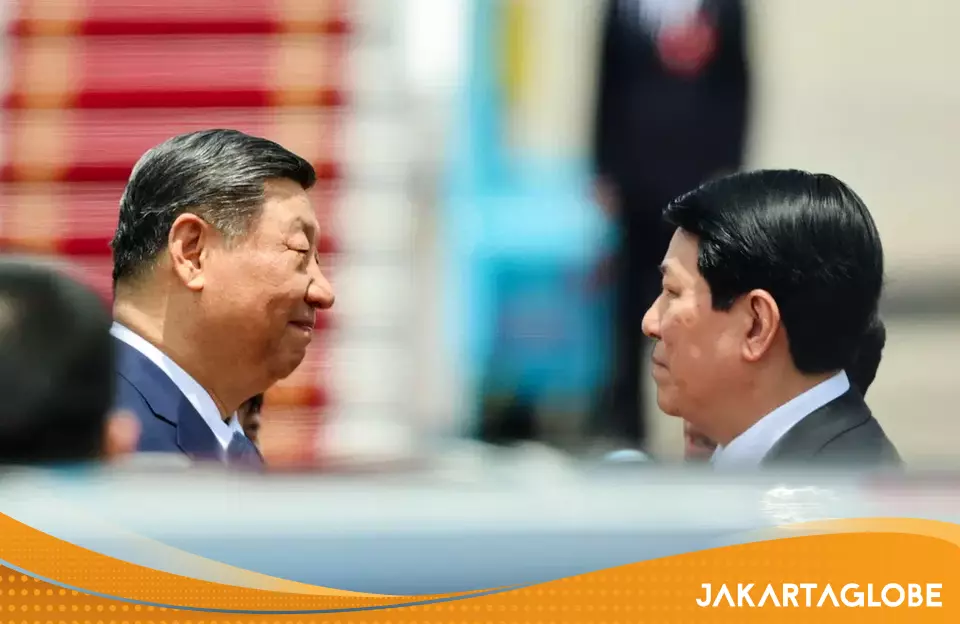Xi Jinping Visits Southeast Asia, Emphasizes Trade Stability Amid U.S. Tariff Tensions
By Archyde News Journalist
HANOI – Chinese President Xi Jinping began a significant diplomatic tour of Southeast Asia on Monday, using the opportunity to position China as a pillar of stability amidst ongoing trade friction with the United States. His visit comes as the U.S., under successive administrations, has grappled with how to address its trade imbalance with China, employing tariffs and other measures to protect American industries.
While President Trump initiated a series of tariffs, some of which have seen adjustments, substantial duties remain on chinese imports, impacting the world’s second-largest economy. These tariffs, which at one point reached 45 percent, are a point of contention.
In a joint editorial published by Vietnamese and Chinese media, Xi Jinping underscored his stance:
There are no winners in a trade war, or a tariff war.
He further emphasized the need for both nations to
resolutely safeguard the multilateral trading system, stable global industrial and supply chains, and an open and cooperative international habitat.
Nguyen Khac Giang, a visiting fellow at Singapore’s ISEAS–yusof Ishak Institute, noted that Xi’s visit allows China to project itself as a
responsible superpower,
notably in contrast to the perceived unpredictability of U.S. trade policy.This positioning coudl resonate with many U.S. allies in the region that are keen on hedging their bets.
A Warm Welcome in Hanoi
Xi Jinping’s arrival in Hanoi was marked by a ceremonial welcome,with Vietnam’s President Luong Cuong receiving him on the tarmac. According to Nguyen Thanh trung, a professor of Vietnamese studies at Fulbright University Vietnam, such a reception is
an honor not often extended to foreign dignitaries.
The welcome included a drum performance and the waving of Chinese and Communist Party flags.
The visit, though likely planned in advance, gains increased importance because of the ongoing trade tensions between China and the U.S. it presents an avenue for Beijing to reinforce regional alliances and identify strategies to mitigate the impact of U.S.-imposed trade barriers. For U.S. businesses, this means watching how these relationships evolve and adapting their own supply chains accordingly.
Commitment to Peaceful Growth
During his stay in Hanoi, Xi met with Vietnam’s Communist Party General Secretary To Lam, emphasizing the shared commitment to peaceful development between the two nations. He stated that their partnership contributes to
stability and certainty to the global stage.
This is particularly significant in the context of the South China Sea disputes, where both countries have overlapping claims.
Meetings with Vietnam’s Prime Minister Pham Minh Chinh also took place, resulting in the signing of several memorandums of understanding, the details of which remain undisclosed. However, according to Nhan dan, the official mouthpiece of vietnam’s Communist Party, china and Vietnam plan to expedite an $8 billion railway project that was initially approved in February. This project underscores the growing economic ties between the two nations and their commitment to infrastructure development.
Political Messaging and Regional Implications
Huong Le-Thu from the International Crisis Group emphasizes the political undertones of the visit,noting that it signals the strategic importance of Southeast Asia to China.
The timing of the visit sends a clear political message, signaling Southeast Asia’s importance to China.
The U.S. tariffs create uncertainty among Southeast Asian nations, raising concerns about potential disruptions to their economic growth, which is a key factor for the region’s stability.
Vietnam has successfully navigated its relationships with both the U.S. and China. While maintaining a communist, one-party system akin to China, it has also cultivated strong ties with the U.S. In a notable diplomatic feat in 2023, Vietnam hosted both U.S. President Joe Biden and chinese President Xi Jinping. Moreover, Vietnam elevated its diplomatic relations with the U.S. to the same level as those with china and Russia.
Economic Dynamics and Trade War Fallout
In 2024, trade between China and Vietnam experienced a surge of 14.6 percent, solidifying China’s position as Vietnam’s largest trading partner. This growth underscores the increasing economic interdependence between the two countries.
Vietnam has also benefited from businesses seeking alternatives to China,attracting companies looking to diversify their supply chains.However, as Giang points out, the escalating trade war places vietnam in a
precarious situation,
with the U.S. potentially viewing it as a conduit for Chinese goods. Prior to a temporary 90-day tariff pause, Vietnam faced a 46 percent tariff imposed by the U.S.,highlighting the risks it faces amid the ongoing trade disputes. The U.S. has been increasing scrutiny on goods entering from Vietnam to ensure they are not simply Chinese goods being re-exported to avoid tariffs.
Navigating Territorial Disputes
Despite their robust trade relations, China and Vietnam have unresolved territorial disputes in the South China Sea. While there have been confrontations between Vietnam and China’s coast guard, Vietnam generally avoids publicizing these incidents. This delicate balancing act is key to maintaining stability in the region.
Future Engagements
Following his visit to Vietnam, Xi Jinping is scheduled to continue his diplomatic tour with visits to Malaysia and Cambodia. These engagements underscore China’s commitment to strengthening its ties with Southeast asian nations and promoting regional cooperation.
Impact on U.S. Businesses and Consumers
The dynamics between China and Southeast Asian nations have direct implications for U.S. businesses and consumers. The trade war has led to increased costs for some goods,as tariffs are often passed on to consumers. Businesses with supply chains reliant on China have had to consider diversifying to countries like Vietnam, which can present both opportunities and challenges.
Such as, a U.S. clothing retailer that previously sourced all its products from China might now split its production between China and Vietnam to mitigate the impact of tariffs and reduce reliance on a single source. This diversification could lead to changes in product costs, quality, and lead times.
Potential Scenarios and Future Outlook
Several scenarios could unfold in the coming months:
- The U.S.and China could reach a comprehensive trade agreement, reducing or eliminating tariffs and easing trade tensions.
- The trade war could escalate, with further tariffs and restrictions imposed by both sides.
- The current situation could persist, with ongoing trade friction and uncertainty.
Each of these scenarios would have different implications for U.S. businesses, consumers, and the global economy.
How do you believe the ongoing U.S.-China trade tensions and Xi Jinping’s diplomatic moves will impact the long-term economic stability of Southeast Asia and the strategies of U.S businesses?
Interview: Navigating Trade Wars – Expert Insights on Xi Jinping’s Southeast Asia Tour and U.S.-China Tensions
Introduction
Welcome to Archyde News.Today, we’re joined by Dr. Anya Sharma, Senior Economist at the Global Trade Institute, to discuss the implications of Chinese President Xi Jinping’s recent tour of Southeast Asia, particularly in the context of ongoing U.S.-China trade tensions. Dr. Sharma, welcome.
Dr. Sharma: Thank you for having me.
Xi Jinping’s Diplomatic Strategy
Archyde News: Dr. Sharma, could you elaborate on the importance of Xi Jinping’s visit? What message is China trying to send by emphasizing trade stability in this region, especially with the U.S. imposing tariffs?
Dr. Sharma: Xi’s tour is a strategic move. China aims to position itself as a reliable partner amidst the unpredictability of U.S. trade policy. By highlighting its commitment to multilateral trade and infrastructure advancement, particularly evident in the $8 billion railway project with Vietnam mentioned in your report, China is projecting an image of stability and economic opportunity in a region wary of the trade war fallout.
archyde News: The joint editorial Xi penned with Vietnamese media, where he stated, “There are no winners in a trade war,” seems significant. How does this messaging resonate?
Dr. Sharma: Absolutely. That quote is the crux of China’s diplomatic strategy. It appeals to Southeast Asian nations keen on hedging their bets. It subtly critiques U.S. policy while offering itself as a counterbalance, promoting an habitat of cooperation and shared economic interests.
Impact on Regional Economies
Archyde News: Vietnam’s role seems particularly fascinating. It has robust trade with China, yet also strong ties with the U.S. How is Vietnam navigating amid these major geopolitical shifts?
Dr. Sharma: Vietnam is walking a tightrope. It benefits from both, serving as a gateway for Chinese goods while attracting businesses diversifying their supply chains. However,it’s also in a precarious situation. The U.S. scrutinizes goods entering from Vietnam to prevent Chinese goods re-exported to avoid tariffs. This presents both opportunities and risks as vietnam’s economic relationship with both countries evolve.
Archyde News: You mentioned the U.S. is scrutinizing goods entering from Vietnam to prevent Chinese goods from being relabeled. Can you elaborate on some specific challenges faced by these nations as the trade war continues?
Dr. Sharma: The scrutiny introduces potential delays, raising costs, and disrupting the supply chain for businesses, both in Vietnam and the U.S. This can lead to increased product costs and further economic uncertainly.
Implications for U.S.businesses and Consumers
Archyde News: What immediate implications does this have for U.S. businesses and consumers? Should they consider these changes?
Dr. Sharma: U.S. businesses need to carefully monitor the evolving trade environment.tariffs, as we know, drive up costs, in the consumer market. Companies with supply chains relying on China must diversify to minimize risks.The U.S.clothing retailer example highlights the immediate strategy that impacts the consumer.
Archyde News: Could you elaborate on the potential scenarios that can unfold for the U.S. and China relationship?
Dr. Sharma: Several scenarios are possible. The U.S. and China may reach a extensive trade agreement, easing tensions; the trade war can escalate; or the current situation continues. Each of these scenarios will impact U.S. businesses, and the global economy.
Future outlook and Discussion
Archyde News: Dr. Sharma, what is your most significant takeaway from Xi’s Southeast Asia tour, and what should our readers be watching for in the coming months?
Dr. Sharma: The most significant takeaway is China’s firm commitment to bolstering its influence in Southeast Asia thru trade and infrastructure development, particularly regarding the china-Vietnam railway. Readers should watch closely for the development of the U.S.-China trade talks and the outcomes. This period will further shape the economic landscapes globally and specifically in the Southeast Asian region.
Archyde News: Dr. Sharma, thank you for your insights.
Dr. Sharma: My pleasure.
Archyde News: We encourage our readers to share their thoughts on the comments section provided below: How do you believe the ongoing U.S.-China trade tensions and Xi Jinping’s diplomatic moves will impact the long-term economic stability of Southeast Asia and the strategies of U.S businesses?








